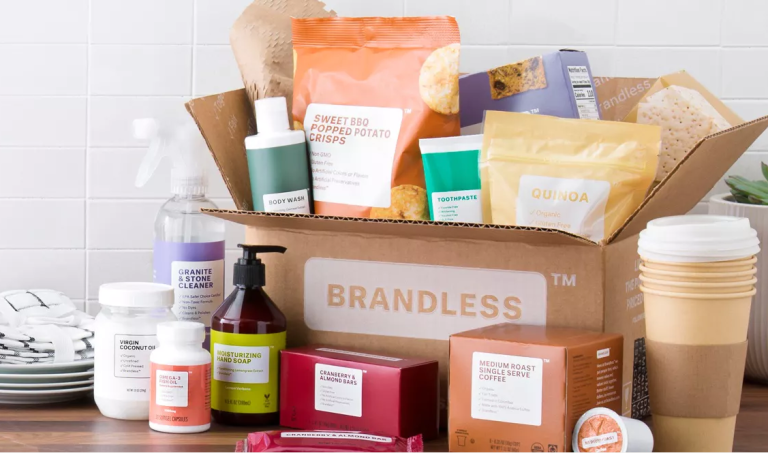The Beauty Of Being Brandless

Millennials, on average, are less brand-loyal than their parents or older siblings. They tend to like quality, have a strong preference for shopping online and enjoy a good bargain – but when it comes to buying from a specific brand? Not so much.
It was an insight that pushed Brandless CEO and Co-founder Tina Sharkey to rethink an online commerce offering in a very fundamental way, by eliminating what she calls the “brand tax.” That tax, she noted, encompasses marketing, retailer margins and other expenses that can typically push up prices on brand-name products by as much as 30 percent.
But consumers can’t wear, eat, clean with or really use all of those marketing expenses – and so Brandless decided to stop them in favor of offering a $3 (almost) across-the-board price tag, a streamlined assortment of goods and a simple design for its packaging materials, which recall an era before private-label packaging was an exercise in artistic design.
That appeal to simplicity, in fact, defines much of the Brandless experience.
Over the last three years, the firm has been vetting, tasting and sampling hundreds of formulations to create products that satisfy modern needs and value. To make the cut and join the brand that doesn’t want to be one, goods must be simple, non-GMO, organic, fair trade, kosher, gluten-free and/or no sugar added. They are packaged to limit waste and labeled for maximum transparency. And while Brandless’ selection of goods can look a bit small when stacked against the counts of mega-players like Amazon, it is hard to argue that its collection is relevant.
Brandless’ retail repertoire now includes food products (canned goods, snacks, sauces, coffee), housewares (can openers, corkscrews, kitchen knives), cleaning supplies (dish soap, all-purpose cleaners, health and beauty products, toothpaste, hand soap) and office supplies.
Basically: the basics. The magic, according to Sharkey, is in limiting consumer choice. The only brand is the Brandless store brand, which means instead of 30 toothpaste choices, there is only one. All in, the firm sells about 300 items on its website – all generic household staples, mostly for $3 a shot.
And consumers aren’t the only one buying.
Masayoshi Son, chief executive officer of SoftBank – which just dropped $240 million into the firm – was described as “a bit flabbergasted” by the range of goods offering by Brandless, all in that $3 window. The deal values Brandless at about $500 million.
The price point is particularly impressive, observers have noted, because Brandless is not known to sell down market goods. In their listings, the products are fairly upscale-sounding in that they include words like “organic” and “gluten-free” – terms that have become associated with “expensive” and “really expensive.”
The question, of course, is how eCommerce general merchandise like Brandless will hold out against Amazon, the reigning king of the segment and competition killer.
But Sharkey said she doesn’t see Amazon as a direct competitor. “Amazon is the everything store,” she noted. “We’re a highly curated collection.”
And that curation is becoming more about building a community – or dare we say an ecosystem – around the Brandless collection of goods. Doing so might include adding recipes to the site that point the reader to all the right ingredients, or even hosting the occasional pop-up shop.
And with the infusion of cash from SoftBank – not to mention two SoftBank executives joining its board – the construction and expansion of that brand-free ecosystem seems to be going full speed ahead into the back end of 2018. Jeff Housenbold, one of the two SoftBankers joining Brandless’ board, said the company’s ability to generate buzz around ho-hum products and its incredible facility with the data were two powerful selling points, apart from their highly competitive pricing.
The challenge, according to market watchers, is scale – particularly if the company wants to survive in the Amazon age. According to Sucharita Kodali, an analyst at Forrester Research Inc., Brandless’ area of focus, commodity goods, has two big issues: They tend to be low margin and they can be expensive to ship.
“They need to get people to add lots of items to a cart to make things cost-effective, or to have a chance at profitability,” Kodali said. “This is about volume, lots of repeat customers.”
Amazon, she noted, could at any time “crush them” if Jeff Bezos decided to go after them on price on every product.
Will Amazon do that, though? Brandless is perhaps too small for Seattle to take much notice just yet. However, the 90-employee site is working diligently to slowly but surely get more consumers hooked on the Brandless brand.
The site will be expanding its inventory by year-end, up to 400 products. The hope is that when Amazon comes to call, the not-so-loyal millennial consumers might just have found the non-brand to stick with.